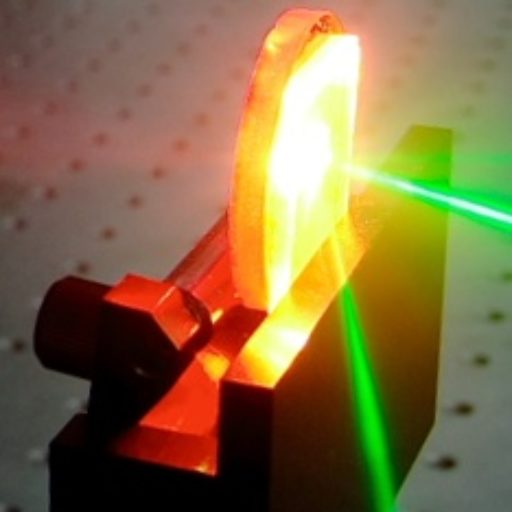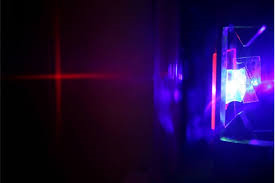Organic Lasers
Organic semiconductors have shown great potential as laser gain materials due to a combination of high available optical gain, solution processability and broad emission spectra. Only a thin film of material is required to achieve lasing leading to a great flexibility in the form and shape of organic lasers that range from microcavities such as microspheres and micro rings to distributed-feedback (DFB) lasers where the gain region is only a few hundred nanometres thick. The broad emission of these materials allows organic lasers to be highly tuneable across their emission spectrum while the ability to modify their optical properties through synthetic chemistry leads to laser devices that span the visible spectrum.

Our research covers all aspects of organic semiconductor lasers, from fundamental research to device manufacturing and testing. We investigate new materials by performing complete photophysical characterisations and evaluate their potential as laser gain media. Resonator design allows for optical feedback that matches the emission spectrum of different materials and can be tailored to match the needs of different applications. We combine these two aspects of laser design to fabricate and test complete devices, evaluating all operational aspects such as lasing threshold, efficiency and device lifetime. We also explore new aspects of organic lasers such as alternative optical pumping schemes and new applications that make use of the unique properties of this fascinating family of lasers.
Below are some examples of new materials, fabrication techniques and novel devices that highlight the fascinating nature and great diversity of organic semiconductor lasers:
LED pumped polymer laser
Electrically excited organic lasers are yet an impossibility due to the low carrier mobilities in organic semiconductors. The low carrier mobilities lead to several problems, for example injected charge absorption loss and electrical contact loss, which both increase the pump energy required to reach the lasing threshold. Alternatively, by utilising the advantages of inorganic semiconductors, our group demonstrated a world first, a hybrid device with a polymer laser pumped by a high power InGaN light emitting diode (LED). The LED pumped polymer laser exhibits all the benefits of a direct electrically pumped laser (e.g. compact, cheap, current/voltage controlled etc.), thus reducing the size and the cost of the polymer laser system. Shown on the left is the emission spectra from the yellow emitting polymer laser under different drive currents applied to the LED. When the current is increased up to 148 amperes the photoluminescence increases linearly. A further increase of the drive current results in a peak appearing at 568 nm, close to the second dip of the spectrum where the Bragg scattering stop band is. The full-width-half-maximum of the peak is 1.1 nm, indicating that the device is lasing.

High performance organic semiconductor lasers
Our group is recognised as one of the premier organic laser groups in the world, making cutting-edge advances in the field. We investigate new materials by performing complete photophysical characterisations and evaluate their potential as laser gain media. DFB lasers are fabricated base on nanoimprinted grating and high-performance gain media.
Perovskite distributed feedback lasers
High luminescence efficiency has made perovskites an attractive prospect as a new class of light-emitting material for thin film light-emitting diodes and lasers. Our group demonstrate the first visible perovskite distributed feedback laser.